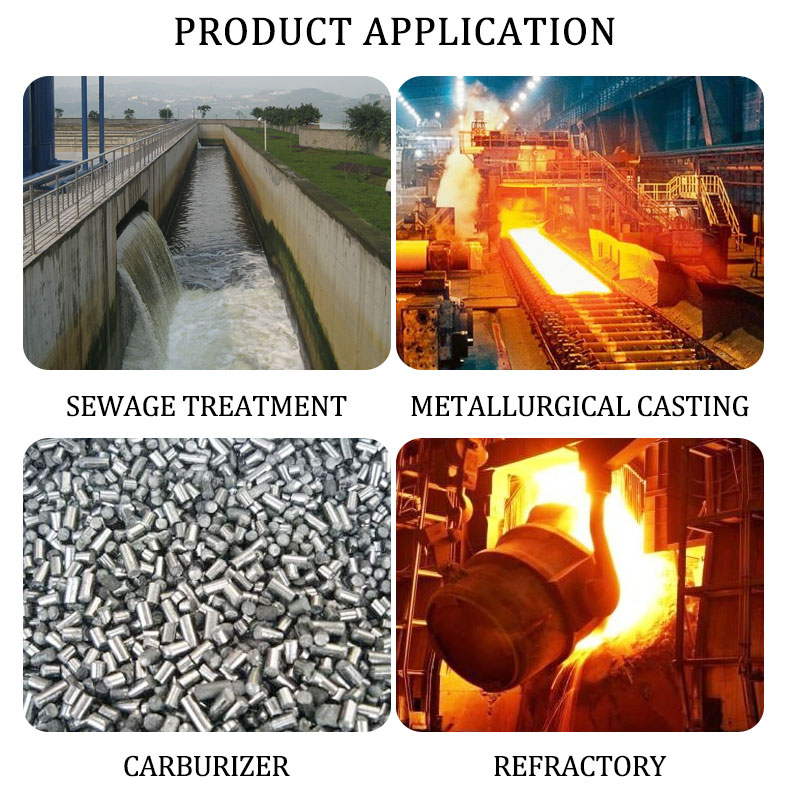Petroleum coke is a black or dark gray hard solid petroleum product with metallic luster and is porous.
Petroleum coke components are hydrocarbons, containing 90-97% carbon, 1.5-8% hydrogen, nitrogen, chlorine, sulfur and heavy metal compounds. Petroleum coke is a by-product of the pyrolysis of feedstock oil in delayed coking units at high temperatures to produce light oil products. The output of petroleum coke is about 25-30% of the raw oil. Its low calorific value is about 1.5-2 times that of coal, the ash content is not more than 0.5%, the volatile matter is about 11%, and the quality is close to anthracite. According to the structure and appearance of petroleum coke, petroleum coke products can be divided into 4 types: needle coke, sponge coke, projectile coke and powder coke:
(1) Needle coke, with obvious needle-like structure and fiber texture, is mainly used as high-power and ultra-high-power graphite electrodes in steelmaking. Since needle coke has strict quality index requirements in terms of sulfur content, ash content, volatile matter and true density, there are special requirements for needle coke production technology and raw materials.
(2) Sponge coke, with high chemical reactivity and low impurity content, is mainly used in aluminum smelting industry and carbon industry.
(3) Projectile coke or spherical coke: It is spherical in shape and 0.6-30mm in diameter. It is generally produced from high-sulfur and high-asphaltene residual oil and can only be used as industrial fuels such as power generation and cement.
(4) Powder coke: It is produced by fluidized coking process, with fine particles (0.1-0.4mm in diameter), high volatile content and high thermal expansion coefficient, so it cannot be directly used in electrode preparation and carbon industry.
According to the different sulfur content, it can be divided into high-sulfur coke (sulfur content above 3%) and low-sulfur coke (sulfur content below 3%). Low-sulfur coke can be used as anode paste and prebaked anodes for aluminum plants and as graphite electrodes for steel plants. Among them, high-quality low-sulfur coke (sulfur content less than 0.5%) can be used to produce graphite electrodes and carbon enhancers. Low-sulfur coke of general quality (less than 1.5% sulfur) is often used to produce prebaked anodes. Low-quality petroleum coke is mainly used for smelting industrial silicon and producing anode paste. High-sulfur coke is generally used as a fuel in cement plants and power plants.
Calcined Petroleum Coke:
In the case of graphite electrodes for steelmaking or anode pastes (melting electrodes) for aluminum and magnesium production, in order to adapt the petroleum coke (green coke) to the requirements, the green coke must be calcined. The calcination temperature is generally around 1300 ° C, the purpose is to remove the volatile components of petroleum coke as much as possible. In this way, the hydrogen content of the recycled petroleum coke can be reduced, and the graphitization degree of the petroleum coke can be improved, thereby improving the high temperature strength and heat resistance of the graphite electrode, and improving the electrical conductivity of the graphite electrode. Calcined coke is mainly used in the production of graphite electrodes, carbon paste products, diamond sand, food-grade phosphorus industry, metallurgical industry and calcium carbide, among which graphite electrodes are the most widely used. The green coke can be directly used for calcium carbide as the main material of calcium carbide without calcination, and to produce silicon carbide and boron carbide as abrasive materials. It can also be directly used as coke for blast furnace in metallurgical industry or carbon brick for blast furnace wall lining, and can also be used as dense coke for casting process.

Post time: Jul-13-2022

